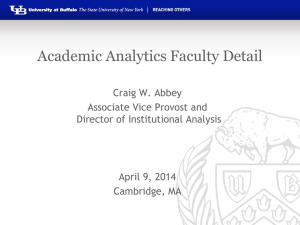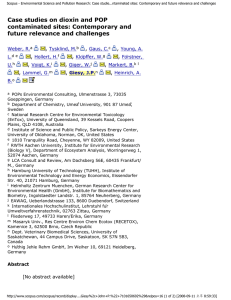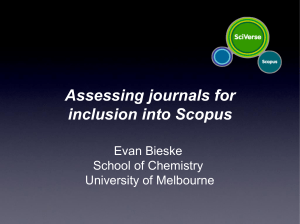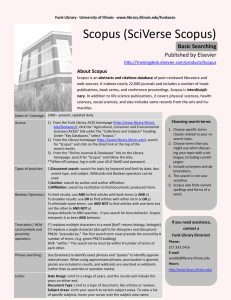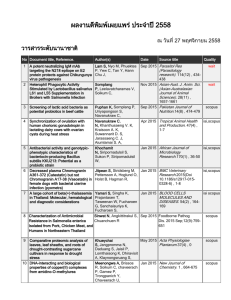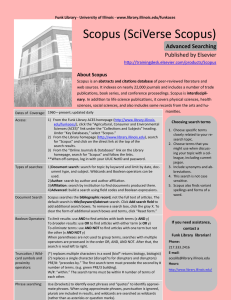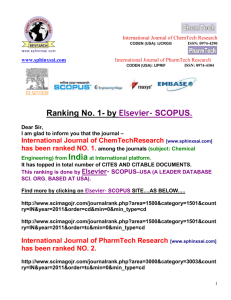Identifying Research Strengths through Bibliometric Analysis
advertisement
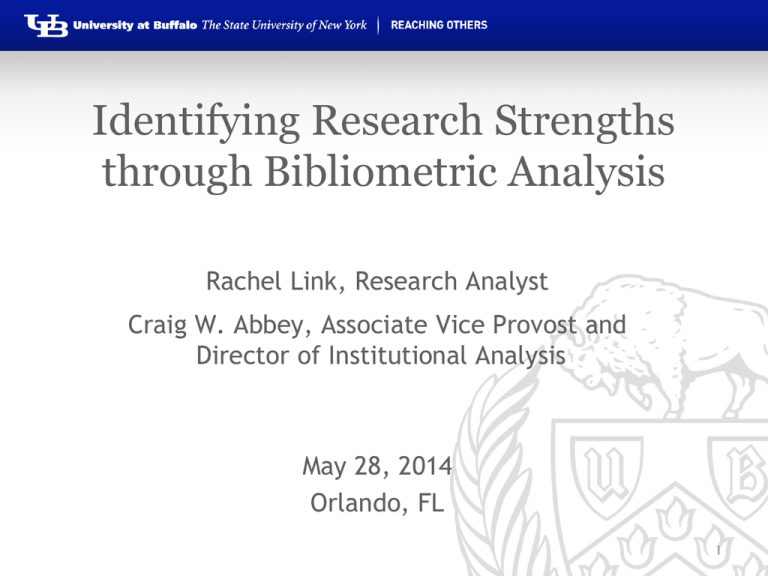
Identifying Research Strengths through Bibliometric Analysis Rachel Link, Research Analyst Craig W. Abbey, Associate Vice Provost and Director of Institutional Analysis May 28, 2014 Orlando, FL 1 What is Bibliometric Analysis? The use of statistical methods in the analysis of a body of literature to reveal the historical development of subject fields and patterns of authorship, publication, and use. Most common uses: citation analysis and assessment of academic impact. Source: ALA Glossary of Library and Information Science 2 UB’s Use of Bibliometric Analysis • • • • Understanding faculty contributions Benchmarking against peer institutions Examining research strengths Understanding collaborations 3 Examining Research Strengths: Software Tools 4 Examining Research Strengths: Data Sources 5 UB Publications Volume by Broad Journal Discipline Source: Global Research Benchmarking System, 2010 6 UB Citation Volume by Broad Journal Discipline Source: Global Research Benchmarking System, 2010 7 Multidisciplinary Median = 24.1 Source: Global Research Benchmarking System, 2010 8 9 Source: Global Research Benchmarking System, 2010 10 Source: Global Research Benchmarking System, 2010 11 Source: Global Research Benchmarking System, 2010 Understanding Collaborations: Data Preparation • • • Scopus article listing for 2008-12 Academic Analytics Details Database Institutional human resources data 12 Scopus Data Process Scopus dataset loaded into Excel Editing, cleaning, collating, and formatting Merging with UB HR data Faculty view created Single-article view created Matrices created 13 Academic Analytics Data Process ASJC UB Structure CoAuthorship Matrix AA Journals List AA Faculty Articles 14 • • • • Visualization in a circular format Makes relationships apparent Customization options Free to use More information: http://www.circos.ca 15 Co-Authorship on Pharmacology, Toxicology and Pharmaceutics Articles Scopus 2008-12 data 16 Co-Authorship on Materials Science and Advanced Manufacturing Articles Source: Scopus 2009-2012 17 Top Scholars Name Jones, William A. Morrison, David E. Smith, Diana K. Frank, Adam P. Johnson, Mable T. Thompson, James A. Brown, Frank P. Chang, Gao Patterson, Margaret R. Source: Scopus 2009-2012 Unit Department Count of Articles PHARM PHARM PHARM PHARM PHARM PHARM CAS SMBS PHARM Pharmaceutical Sciences Pharmaceutical Sciences Pharmaceutical Sciences Pharmacy Pharmaceutical Sciences Pharmacy Biological Sciences Pharmacology And Toxicology Pharmacy 31 28 25 23 15 14 13 12 6 Sum of Citations Citations per Article 180 150 206 261 77 194 55 122 87 5.8 5.4 8.2 11.3 5.1 13.9 4.2 10.2 14.5 18 • Excel template that “plugs in” to Microsoft Excel • Easy to use and customize • Free to download and use • Works well with larger data sets More information: http://nodexl.codeplex.com 19 Co-Authorship on Pharmacology, Toxicology and Pharmaceutics Articles Source: Scopus 2008-12 20 Co-Authorship on Materials Science and Advanced Manufacturing Articles Scopus 2008-12 data 21 • Text visualization tool • Free to use • Allows removal of common words, or any words of your choosing • Can recognize strings and phrases if data are formatted for that purpose More information: http://www.wordle.net/ 22 Pharmacology, Toxicology and Pharmaceutics UB Article Keywords Scopus 2008-12 data 23 Materials and Advanced Manufacturing UB Article Keywords Source: Scopus 2009-2012 24 UB uses of bibliometric analysis • • • • Analyzing faculty productivity and impact Resource allocations & investment planning Unit and departmental collaborations Inter-university collaborations 25 Questions? Craig W. Abbey cwabbey@buffalo.edu Rachel Link rlink2@buffalo.edu 26
